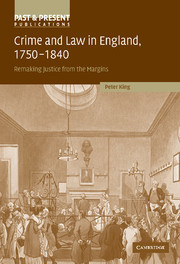Book contents
- Frontmatter
- Contents
- Preface
- List of figures
- List of tables
- 1 Shaping and remaking justice from the margins. The courts, the law and patterns of lawbreaking 1750–1840
- Part I Juveniles
- Part II Gender
- Part III Non-lethal violence
- 7 Punishing assault: the transformation of attitudes in the English courts
- 8 Changing attitudes to violence in the Cornish courts 1730–1830
- Part IV The attack on customary rights
- Index
- Past and Present Publications
7 - Punishing assault: the transformation of attitudes in the English courts
Published online by Cambridge University Press: 25 July 2009
- Frontmatter
- Contents
- Preface
- List of figures
- List of tables
- 1 Shaping and remaking justice from the margins. The courts, the law and patterns of lawbreaking 1750–1840
- Part I Juveniles
- Part II Gender
- Part III Non-lethal violence
- 7 Punishing assault: the transformation of attitudes in the English courts
- 8 Changing attitudes to violence in the Cornish courts 1730–1830
- Part IV The attack on customary rights
- Index
- Past and Present Publications
Summary
In early modern England physical violence was regarded as an acceptable instrument of social policy and of individual and group interaction by almost all sectors of society. There were dissenting voices and differences of emphasis, but violence was accepted as the primary means by which the state punished offenders. It was also an intrinsic part of many popular recreations, and was usually seen as a legitimate way to resolve interpersonal disputes. This atmosphere of acceptance changed rapidly, if by no means uniformly, in the late eighteenth and early nineteenth centuries, but research on this vital transition has been confined largely to the first two of these three dimensions.
Many historians have identified the later eighteenth and early nineteenth centuries as a period of fundamental change in attitudes to judicial violence. The replacement of public and physically violent punishments such as hanging, whipping, and branding by new carcereal strategies has been subjected to detailed analyses, as have the parallel attacks of the authorities on such forms of popular recreation as cudgelling and bull-baiting, which involved physical violence against either people or animals. However, virtually no research has been undertaken on the changing ways in which the courts punished interpersonal violence. These judicial policies form the main focus of this paper.
Murder and rape, which were capital felonies, have been studied fairly extensively. Here the sentencing options were relatively clear cut. Full conviction meant a capital sentence, and only by various forms of partial verdict could other sentences be used.
- Type
- Chapter
- Information
- Crime and Law in England, 1750–1840Remaking Justice from the Margins, pp. 227 - 254Publisher: Cambridge University PressPrint publication year: 2006



